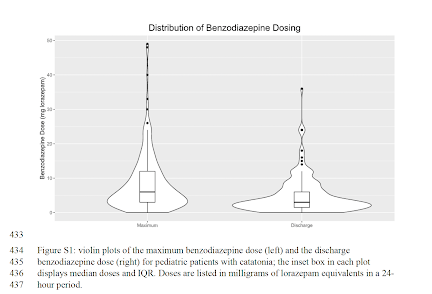Catatonia in Pediatric Patients: New Data From Two US Academic Medical Centers
Out on PubMed, from researchers in Boston and Nashville, is this paper:
Exploring the Trajectory of Catatonia in Neurodiverse and Neurotypical Pediatric Hospitalizations: A Multicenter Longitudinal Analysis.medRxiv [Preprint]. 2024 Jun 7:2024.06.06.24308554. doi: 10.1101/2024.06.06.24308554.PMID: 38883751
The abstract is copied below:
Objective: Catatonia is a neuropsychiatric disorder that occurs in pediatric patients with a range of associated medical, psychiatric, and neurodevelopmental disorders (NDDs). This study describes hospital care of pediatric catatonia patients and compares treatments for neurotypical patients and those with NDDs.Methods: Retrospective cohort study from 1/1/2018 to 6/1/2023 of two academic medical centers of patients aged 18 and younger with catatonia. Patients were retrospectively assessed using the clinical global impressions-improvement (CGI-I) by two independent reviewers.
Results: One hundred sixty-five patients were hospitalized for catatonia, of whom 50.3% had an NDD. Median age was 15. One hundred sixty-four patients were treated with a benzodiazepine, with a median maximum 24-hour dose of 6 mg lorazepam-equivalents, which did not differ for patients with and without NDDs. Electroconvulsive therapy (ECT) was utilized in 14.5% of patients. Median length of medical hospitalization was 5 days and hospitalizations were longer in neurotypical patients than in patients with NDDs. In an ordinal regression model, the probability of observing at least "much improvement" (CGI < 3) was 88.3% (95% CI: 82.4% to 92.3%), with NDD diagnosis associated with a lower odds of clinical response.
Conclusions: The probability of patients achieving a CGI-I score indicating at least "much improvement" was 88.3%. Administered benzodiazepine dose and ECT treatment were similar for all patients, but neurotypical patients had longer hospitalizations than those with NDDs and had a higher odds of a more favorable clinical response. Research under controlled conditions is needed to optimize and endure equitable catatonia treatment in youth.
Keywords: catatonia; child psychiatry; cohort studies; neurodevelopmental disorders.
The paper is here.
And from the text:
Here are some very interesting retrospective data about hospital treatment of pediatric catatonia. Of note, only 15% of patients required ECT.
Please also note that this is a pre-print, not yet peer reviewed. This is another example of getting into PubMed before review. Here is where it is published:
This is a high quality paper from a known first author, so there is little problem in this specific instance. In other situations one would need to be very cautious indeed...







Comments
Post a Comment